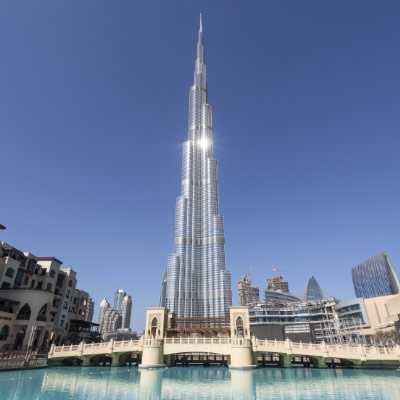UAE
About Country
UAE
UAE's Geographical Location and Population Composition
The United Arab Emirates (UAE), situated at the southeastern tip of the Arabian Peninsula, holds a strategically significant geographical position and features a diverse population. It shares borders with Oman to the southeast and Saudi Arabia to the south, and enjoys coastlines along the Arabian Gulf to the north and the Gulf of Oman to the east.
The population of the UAE is a rich mosaic of cultures, with Emiratis forming the majority, along with a substantial expatriate community hailing from all corners of the globe. Dubai and Abu Dhabi are the largest and most populous cities, serving as economic and cultural hubs.
The UAE's geographic location has made it a bustling center for trade, tourism, and economic development. With its impressive modern infrastructure, iconic skyscrapers, and diverse landscapes that include deserts, coastlines, and mountains, the UAE offers a unique blend of tradition and innovation, making it an appealing destination for tourists and expatriates alike.
Climate conditions and tourism situations in different seasons
The United Arab Emirates (UAE) enjoys a desert climate with distinct seasons, offering diverse tourism experiences.
Winter, from November to February, boasts pleasant temperatures, attracting travelers to explore the desert landscapes comfortably. Dubai's bustling markets and outdoor activities, such as desert safaris, are popular.
Spring, in March to May, brings warmer weather and is ideal for water sports along the UAE's beautiful coastlines. Fujairah's beaches and the Hajar Mountains offer pleasant escapes.
Summer, from June to September, is hot and dry, drawing tourists to the cooler mountain regions like Ras Al Khaimah and Hatta. This is also the season for indoor attractions and shopping festivals.
Autumn is a fantastic time for cultural experiences as the weather cools down. Dubai's cultural festivals, Abu Dhabi's heritage sites, and Sharjah's art events are alluring.
The UAE's diverse seasons ensure that there is always something exciting to explore, from sand dunes to beaches, mountains, and vibrant cityscapes.
UAE's Cultural Cities
The United Arab Emirates is home to several significant cities with rich cultural attractions.
Dubai, the most famous, features the historic Al Fahidi Neighborhood, now a cultural district, and the Dubai Opera. The Dubai Museum is housed in the Al Fahidi Fort, showcasing the city's history.
Abu Dhabi, the capital, boasts the magnificent Sheikh Zayed Grand Mosque, an architectural masterpiece. The Louvre Abu Dhabi is a cultural highlight, featuring a diverse collection of art.
Sharjah, designated as the Cultural Capital of the Arab World by UNESCO, offers numerous museums, galleries, and the iconic Al Noor Mosque.
Al Ain, known as the "Garden City," presents the Al Ain Palace Museum and the Al Jahili Fort, offering a glimpse into Emirati heritage.
These cities in the UAE showcase the country's rich cultural and historical legacy, making them essential destinations for travelers seeking a deeper understanding of the Emirates' heritage.
UAE’s Natural Attractions
The United Arab Emirates offers an array of captivating natural attractions for nature enthusiasts.
The Hajar Mountains, stretching across the eastern UAE, provide excellent hiking and rock-climbing opportunities. Jebel Jais, the highest peak, is a popular spot for adventurous activities and offers panoramic views.
The Liwa Oasis in the Empty Quarter Desert, or Rub' al Khali, showcases mesmerizing sand dunes that are ideal for dune bashing and camping.
The UAE's coastline along the Arabian Gulf and the Gulf of Oman offers stunning beaches and vibrant coral reefs, perfect for water sports and underwater exploration.
Al Wathba Wetland Reserve, near Abu Dhabi, is a haven for birdwatchers and those seeking serene natural surroundings.
Mangrove forests, such as the Al Jubail Mangrove Park in Abu Dhabi, provide a unique opportunity for kayaking and eco-tours.
These natural wonders in the UAE offer diverse experiences, from outdoor adventures in the mountains and deserts to tranquil moments by the sea and in the wetlands.
Emirati Cuisine
Emirati cuisine is a delightful and diverse culinary experience for tourists. Traditional dishes reflect the country's rich heritage and Bedouin roots. Al Harees, a dish made from wheat and meat, and Al Majboos, a spiced rice dish often featuring lamb, are staples.
Seafood lovers can relish fresh catches like hammour and kingfish in coastal cities such as Dubai and Abu Dhabi. Dates and Arabic coffee are served as a gesture of hospitality, emphasizing Emirati warmth.
Exploring the flavors of Emirati cuisine is a cultural immersion. Visitors can enjoy meals in traditional settings like Majlis, and many restaurants offer a mix of international and local dishes, making it accessible to various palates.
The fusion of flavors and the cultural significance of food in the UAE make dining an integral part of the travel experience, enticing tourists to savor the country's culinary treasures.


